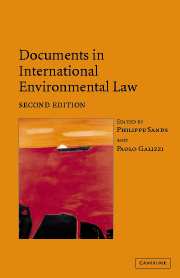Book contents
- Frontmatter
- Contents
- Preface
- PART I General instruments
- PART II Atmosphere
- PART III Oceans: global
- PART IIIB Oceans: regional
- PART IV Freshwater resources
- 14 Convention on the Protection and Use of Transboundary Watercourses and International Lakes, 17 March 1992
- 14A Protocol on Water and Health to the 1992 Convention on the Protection and Use of Transboundary Watercourses and International Lakes, 17 June 1999
- 15 United Nations Convention on the Law of the Non-Navigational Uses of International Watercourses, 21 May 1997
- PART V Biodiversity
- PART VIA Hazardous substances and activities: nuclear
- PART VIB Hazardous substances and activities: pesticides
- PART VIC Hazardous substances and activities: waste
- PART VII Human rights and the environment
- PART VIII War and the environment
- PART IX Trade and the environment
- PART X Environmental impact assessment and access to information
- PART XI Liability for environmental damage and breaches of environmental obligations
- PART XII The Antarctic
15 - United Nations Convention on the Law of the Non-Navigational Uses of International Watercourses, 21 May 1997
Published online by Cambridge University Press: 05 June 2012
- Frontmatter
- Contents
- Preface
- PART I General instruments
- PART II Atmosphere
- PART III Oceans: global
- PART IIIB Oceans: regional
- PART IV Freshwater resources
- 14 Convention on the Protection and Use of Transboundary Watercourses and International Lakes, 17 March 1992
- 14A Protocol on Water and Health to the 1992 Convention on the Protection and Use of Transboundary Watercourses and International Lakes, 17 June 1999
- 15 United Nations Convention on the Law of the Non-Navigational Uses of International Watercourses, 21 May 1997
- PART V Biodiversity
- PART VIA Hazardous substances and activities: nuclear
- PART VIB Hazardous substances and activities: pesticides
- PART VIC Hazardous substances and activities: waste
- PART VII Human rights and the environment
- PART VIII War and the environment
- PART IX Trade and the environment
- PART X Environmental impact assessment and access to information
- PART XI Liability for environmental damage and breaches of environmental obligations
- PART XII The Antarctic
Summary
Editorial note
The 1997 United Nations Convention on the Law of the Non-navigational Uses of International Watercourses (Watercourses Convention) was based on the codification efforts of the International Law Commission (ILC) as reflected in draft Articles on the Law of Non-Navigational Uses of International Watercourses.
The ILC's work began in 1971, following a request from the UN General Assembly. A first reading of a full set of draft Articles was adopted at the ILC's forty-third session in 1991, and a revised set of draft articles was adopted in 1994. The tension between the interests of upstream and downstream states was tangible during the course of the ILC's efforts, and in the diplomatic negotiations leading to the adoption of the 1997 Convention.
The Watercourses Convention applies to uses of international watercourses and their waters for purposes other than navigation and encourages watercourse states to enter into watercourse agreements (Articles 1(1), 3 and 4).
The Convention comprises an introductory section (Part I) and five operational parts. The Convention is without prejudice to rights and obligations arising from agreements already in force (Article 3(1)), and permits states to enter into new agreements which ‘apply and adjust’ its provisions ‘to the characteristics and uses of a particular international watercourse’ (Article 3(3)).
Part II contains general principles. Article 5 of the Convention is of central importance: it provides that watercourse states ‘shall … utilise an international watercourse in an equitable and reasonable manner’, which requires the optimal and sustainable utilisation of the watercourse and its benefits ‘consistent with adequate protection of the watercourse’.
- Type
- Chapter
- Information
- Documents in International Environmental Law , pp. 579 - 598Publisher: Cambridge University PressPrint publication year: 2004
- 4
- Cited by



